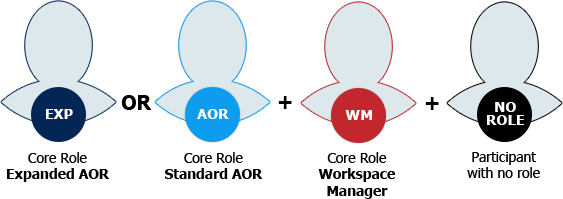Workspace Intermediate
Step-by-Step: Intermediate Approach
The following approach is best suited for small teams of registered users who want to complete webforms and collaborate online.

Minimum Recommended Users for Intermediate Approach
1. Make sure your team members have registered with Grants.gov
Without a Grants.gov account, a team member will not be able to access the workspace and fill out application webforms. For example, if you want three individuals to help complete webforms, then all three should register a Grants.gov account.
2. Design an internal application workflow and assign responsibilities to your team members
Use our interactive workflow graphic and Workspace roles and access chart to help you design your application plan. For example, in our scenario, you will want one collaborator or "participant" to have the Workspace Manager role, so that he or she can create the workspace. You will also want a participant who has one of the core AOR roles (for example, the Standard AOR role), so that the application can be submitted when it has been completed.
3. Log in and create your workspace by clicking on the Apply button on the View Grant Opportunity page of the grant announcement
Any user with the Workspace Manager role or one of the core AOR roles may create the workspace. The user who creates the workspace will also become the Workspace Owner.
4. Add your team members as "Participants" so they can access the application forms
The Workspace Owner (in our scenario, this is the user with the Workspace Manager role) should add Participants to the workspace. At least one Participant should have one of the core AOR roles so that the application can be submitted.
5. Fill in all required form fields
Applicants may choose to complete either the PDF version or the webform version of each form. They may also switch between form types. Data is synced to the workspace upon uploading the PDF forms and upon saving the webforms. Grants.gov recommends that the person completing each form locks access to it, so that others cannot overwrite the work. Want to go deeper? Consider reusing forms from previous workspaces or managing access to budget forms.
6. When all forms have been completed, the Standard/Expanded AOR can be notified and the application submitted
Workspace performs some error checks on form fields automatically. Other checks are run by clicking the Check Application button within the workspace. When the application is ready, the Workspace Owner (if he/she does not have one of the core AOR roles) has the option of clicking the Complete and Notify AOR button. However, at any point after all forms are in the "Passed" status, the Standard/Expanded AOR may log in and click the Sign and Submit button.
7. Track your application and download the submitted application for your offline record-keeping
After submitting, the user with one of the core AOR roles can track the application using the tracking number received from Grants.gov. The Standard/Expanded AOR may also want to download a copy of the submitted application for offline record-keeping. We recommend tracking and downloading the submitted application via the Details tab of the workspace.


